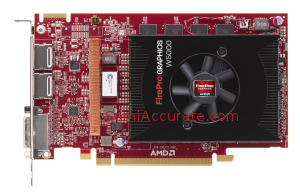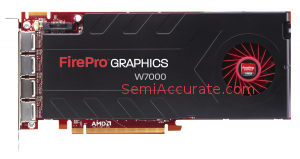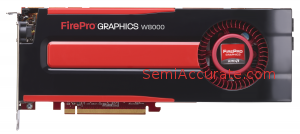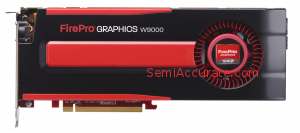Roberto1973
Power Member
AMD FirePro 2012 Lineup
The FirePro professional graphics lineup for 2012 consists of four members.
Here is a breakdown:
AMD FirePro W5000 (“Megamind”)
Cape Verde GL GPU
2 GB GDDR5 (128-bit), 102.4 GB/s memory bandwidth
2× DisplayPort 1.2, 1× DVI-I
<75W power consumption
Single-slot active fansink

AMD FirePro W7000 (“Tighen”)
Pitcairn GL GPU
4 GB GDDR5 (256-bit), 152 GB/s memory bandwidth
4× DisplayPort 1.2
2.4 TFLOPS single-precision, 152 GFLOPS double-precision
Genlock/Framelock
<150W power consumption
1× 6-pin power connector
Single-slot active fansink

AMD FirePro W8000 (“Buzz Lightyear”)
Tahiti XT GL GPU
6 GB GDDR5 (384-bit), 176 GB/s memory bandwidth
4× DisplayPort 1.2, 1× 3-pin DIN (Stereoscopic 3D glasses)
3.23 TFLOPS single-precision, 806 GFLOPS double-precision
Memory ECC support
Genlock/Framelock
<225W power consumption
2× 6-pin power connectors
Dual-slot active fansink

AMD FirePro W9000 (“Woody”)
Tahiti XT GL GPU
1 GHz GPU frequency
1.95 billion triangles per second
6 GB GDDR5 (384-bit), 264 GB/s memory bandwidth
6× DisplayPort 1.2, 1× 3-pin DIN (Stereoscopic 3D glasses)
4 TFLOPS single-precision, 1 TFLOPS double-precision
Memory ECC support
Genlock/Framelock
<300W power consumption
1× 6-pin power connector + 1× 8-pin power connector
Dual-slot active fansink

Update 8/8/12: W8000 changes from 2×8-pin to 2×6-pin. Thanks to Arvid for the correction. Explanation: The train wreck that is AMD PR is to blame for this with seemingly new lows every day.
Same for all GCN-based GPUs, all these professional graphics cards support AMD Eyefinity technology for multi-display workloads, and DirectX 11/OpenGL 4.2 APIs as well as OpenCL 1.2/DirectCompute/C++ AMP. Genlock and framelock functionality will be provided by the FirePro S400 synchronization module, as per usual.
Power efficiency is also important for professional graphics and GPGPU parts as they contribute significantly towards the stability of the product, so the usual AMD PowerTune technology and AMD ZeroCore technology are present in all of the above FirePro offerings, the same for the use of vapor-chamber fansinks.
http://semiaccurate.com/2012/08/07/amd-firepro-2012-lineup/
FirePro A300 Series APUs
The FirePro professional graphics lineup for 2012 consists of four members.
Here is a breakdown:
AMD FirePro W5000 (“Megamind”)
Cape Verde GL GPU
2 GB GDDR5 (128-bit), 102.4 GB/s memory bandwidth
2× DisplayPort 1.2, 1× DVI-I
<75W power consumption
Single-slot active fansink

AMD FirePro W7000 (“Tighen”)
Pitcairn GL GPU
4 GB GDDR5 (256-bit), 152 GB/s memory bandwidth
4× DisplayPort 1.2
2.4 TFLOPS single-precision, 152 GFLOPS double-precision
Genlock/Framelock
<150W power consumption
1× 6-pin power connector
Single-slot active fansink

AMD FirePro W8000 (“Buzz Lightyear”)
Tahiti XT GL GPU
6 GB GDDR5 (384-bit), 176 GB/s memory bandwidth
4× DisplayPort 1.2, 1× 3-pin DIN (Stereoscopic 3D glasses)
3.23 TFLOPS single-precision, 806 GFLOPS double-precision
Memory ECC support
Genlock/Framelock
<225W power consumption
2× 6-pin power connectors
Dual-slot active fansink

AMD FirePro W9000 (“Woody”)
Tahiti XT GL GPU
1 GHz GPU frequency
1.95 billion triangles per second
6 GB GDDR5 (384-bit), 264 GB/s memory bandwidth
6× DisplayPort 1.2, 1× 3-pin DIN (Stereoscopic 3D glasses)
4 TFLOPS single-precision, 1 TFLOPS double-precision
Memory ECC support
Genlock/Framelock
<300W power consumption
1× 6-pin power connector + 1× 8-pin power connector
Dual-slot active fansink

Update 8/8/12: W8000 changes from 2×8-pin to 2×6-pin. Thanks to Arvid for the correction. Explanation: The train wreck that is AMD PR is to blame for this with seemingly new lows every day.
Same for all GCN-based GPUs, all these professional graphics cards support AMD Eyefinity technology for multi-display workloads, and DirectX 11/OpenGL 4.2 APIs as well as OpenCL 1.2/DirectCompute/C++ AMP. Genlock and framelock functionality will be provided by the FirePro S400 synchronization module, as per usual.
Power efficiency is also important for professional graphics and GPGPU parts as they contribute significantly towards the stability of the product, so the usual AMD PowerTune technology and AMD ZeroCore technology are present in all of the above FirePro offerings, the same for the use of vapor-chamber fansinks.
http://semiaccurate.com/2012/08/07/amd-firepro-2012-lineup/
FirePro A300 Series APUs
- Trinity GL APU
- 4 Piledriver CPU Cores
- AMD TurboCore 3.0 Technology for up to 2 cores
- 4 MB L2 Cache
- 384 Radeon Cores (VLIW4 architecture), 24 TMU, 8 ROP
- Dual-channel DDR3-1866 (128-bit)
- AMD HD3D Pro Technology, Stereo 3D Support
- 10-bit display capabilities
- AMD Eyefinity Technology (up to 4 monitors)
- Display Connectivity
- DisplayPort 1.2 (Maximum resolution 4096×2160)
- Single-link or Dual-link DVI
- Single-channel or Dual-channel LVDS3
- Single-link HDMI 1.4a (Maximum resolution 1920×1080)
- 1/4th double-precision rate
- UVD 3.2, VCE 1.0, SAMU 1.0, IOMMU v2
- API Support
- DirectX 11/Direct3D 11, DirectCompute, C++ AMP
- OpenGL 4.2, OpenCL 1.1
- Socket FM2 infrastructure
- AMD FirePro A320 APU
- CPU frequency: 3.8 GHz (Base), 4.2 GHz (TurboCore)
- GPU frequency: 800 MHz
- Floating-point performance (single/double-precision): 736 GFLOPS/184 GFLOPS
- Unlocked APU
- 100W TDP
- Desktop equivalent: AMD A10-5800K
- AMD FirePro A300 APU
- CPU frequency: 3.4 GHz (Base), 4.0 GHz (TurboCore)
- GPU frequency: 760 MHz
- Floating-point performance: 693 GFLOPS/173 GFLOPS
- 65W TDP
- Desktop equivalent: AMD A10-5700
Última edição:




